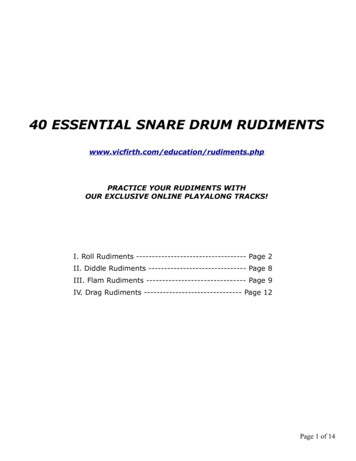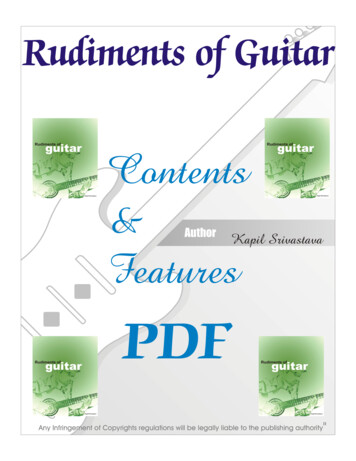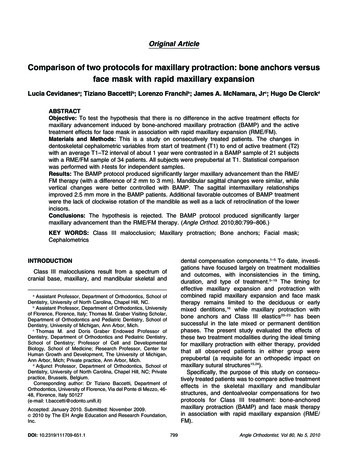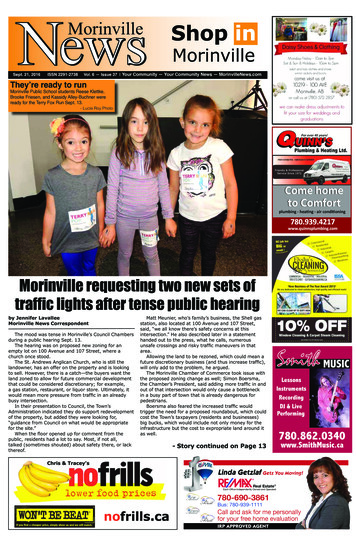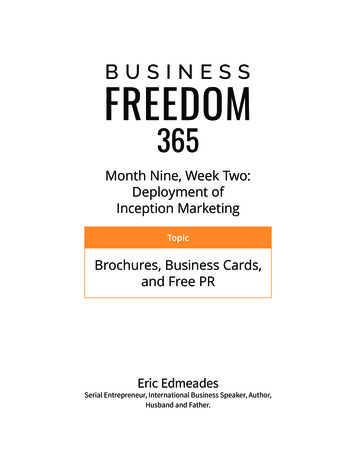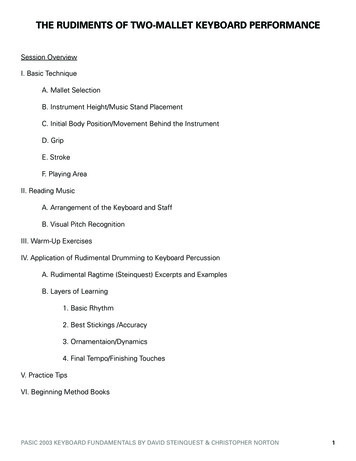
Transcription
THE RUDIMENTS OF TWO-MALLET KEYBOARD PERFORMANCESession OverviewI. Basic TechniqueA. Mallet SelectionB. Instrument Height/Music Stand PlacementC. Initial Body Position/Movement Behind the InstrumentD. GripE. StrokeF. Playing AreaII. Reading MusicA. Arrangement of the Keyboard and StaffB. Visual Pitch RecognitionIII. Warm-Up ExercisesIV. Application of Rudimental Drumming to Keyboard PercussionA. Rudimental Ragtime (Steinquest) Excerpts and ExamplesB. Layers of Learning1. Basic Rhythm2. Best Stickings /Accuracy3. Ornamentaion/Dynamics4. Final Tempo/Finishing TouchesV. Practice TipsVI. Beginning Method BooksPASIC 2003 KEYBOARD FUNDAMENTALS BY DAVID STEINQUEST & CHRISTOPHER NORTON1
INTRODUCTIONThe standard keyboard percussion family of instruments includes the marimba, xylophone, vibraphone, orchestra bells (glockenspiel), and chimes (tubular bells). These instruments share a commonality, namely their similarity of design to a piano keyboard. The first two fundamental areas withwhich a beginner deals are technique—posture, body movement, grip, stroke, playing area—andvisual pitch recognition—the ability to “read” music. This handout gives some cursory informationregarding these fundamental areas.FUNDAMENTAL TECHNICAL CHECKLIST(The following technical tips are widely practiced but certainly may differ from other valid approachesused by some teachers and performers. When trying any technical approach to an instrument, oneshould consider whether the outcome will enhance or inhibit facility and/or sound production.)Height: When possible, adjust the instrument to appropriate height where your forearms are a littleless than perpendicular to the instrument keyboard.Body Movement: Strive for consistency of upper body position to region of notes played; thus, bodymovement should be in a side stepping fashion, or by keeping feet planted and lunging sidewaysfrom knees. Also, avoid standing too close to the instrument since poor mallet placement and strokemay occur.Grip: The two-mallet grip is essentially similar to the matched snare drum grip. Place palms parallelto floor, grip mallet with thumb and first two fingers, let third and fourth fingers curl lightly aroundshaft. The base of the shaft should come out the “fat” of the hand, avoiding the extremes of theknuckles or the center of the wrist. Check fulcrum (balance point) so that the weight of shaft andmallet head yield a full tone while avoiding “heaviness” or lack of facility; generally this fulcum isbetween the thumb and forefinger about 5/8 down the shaft from the mallet head.Stroke: With the wrists at the level of the keyboard, a full stroke consists of beginning with the wristcocked up, striking the bar, and then immediately returning to the starting point— all in one motion.As with all percussion instruments, it is helpful to conceive of drawing the sound out of the instrument rather than hitting into it.Playing area: Playing all bars just slightly off center produces the strongest fundamental pitch andprovides consistency of sound between manuals.2PASIC 2003 KEYBOARD FUNDAMENTALS BY DAVID STEINQUEST & CHRISTOPHER NORTON
FUNDAMENTALS OFREADING PITCHED MUSICThe Grand Staff and the Keyboard1. Staff andCorrespondingKeyboard Placement:Pitches on a grand staff(with bass and treble clef)and their correspondingposition on the pianokeyboard is given at right.The black keys on thepiano correspond withthe upper manual ofkeyboard percussioninstruments.2. Steps/Scales: Traditionalscales are collections ofpitches with consecutiveC Major Scale in Treble Clefletter names. A half-stepoccurs between a givenbar and its closestneighbor (fullyWHOLE WHOLEHALFWHOLEWHOLEWHOLEHALFincorporating upper andlower manuals). A wholestep equals two halfsteps. An ascendingmajor scale consists ofthe following arrangementof whole (W) and half (H)steps: W, W, H, W, W, W,H.Accidentals and the Keyboard3. Accidentals/KeySignatures: A sharp (#)in front of a note raises itone-half step.Conversely, a flat (b )lowers the pitch a halfstep. When an accidentalis placed in the keysignature at thebeginning of the piece, it controls all pitches on that line or space (and octave equivalents) withinthe piece. A natural sign, then, cancels out this global accidental from the key signature—butjust for the measure in which the accidental occurs.&wwwwwwwPASIC 2003 KEYBOARD FUNDAMENTALS BY DAVID STEINQUEST & CHRISTOPHER NORTONw3
4.Pitch Recognition: Learning and memorizing new information often requires extensiverepetition of a small amount of material in order to acquire familiarity. Thus, for a beginner tolearn how to “read” pitches fully and expediently, drilling on a restricted range of pitches isrecommended. When all pitches within a restricted set are instantly identifiable—that is,“learned” rather than “figured out”—then a new overlapping set is introduced. A worksheetemploying this method for treble clef pitches is given below.Pitch Recognition Exercises in Restricted Range Sets& œœœ wœwwwwwwwwE, F, G, A& œœœœ wwwwwwwww& œœœœ wwwwwwwwwG, A, B, Cœ& œœœ wwwwwwwwwB, C, D, EwwwwwwwwD, E, F, Gœœœ wœ&C, D, E, F4PASIC 2003 KEYBOARD FUNDAMENTALS BY DAVID STEINQUEST & CHRISTOPHER NORTON
FUNDAMENTAL TECHNICAL EXERCISESThe following exercises will begin to develop some technical facility on the percussion keyboardinstruments. All examples are in C Major; with the assistance of a teacher and/or method book, thestudent can learn to apply these patterns to other keys. (Note: rolls on keyboard percussion instruments are single-stroke rolls—a rapid succession of alternating strokes.)PASIC 2003 KEYBOARD FUNDAMENTALS BY DAVID STEINQUEST & CHRISTOPHER NORTON5
6PASIC 2003 KEYBOARD FUNDAMENTALS BY DAVID STEINQUEST & CHRISTOPHER NORTON
PASIC 2003 KEYBOARD FUNDAMENTALS BY DAVID STEINQUEST & CHRISTOPHER NORTON7
8PASIC 2003 KEYBOARD FUNDAMENTALS BY DAVID STEINQUEST & CHRISTOPHER NORTON
PRACTICE SUGGESTIONSThe old adage “practice makes perfect” is fundamentally true. An educator’s expanded version ofthis phrase reads “consistent, concentrated, correct practice contributes significantly towards improvement.” Here are a few tips: Plot your day and week; it’s wise to look at your week and determine when and how you canmaintain a regular practice routine.Have a plan for your practice period; an example for a forty- minute session might be to dotechnical exercises for 10 minutes, solo music for 15 minutes, ensemble music for 10 minutes,and sight reading for 5 minutes.Choose a time and space that is free from distraction and full of concentration.Avoid just playing through pieces; real practice occurs when you focus on difficult parts, isolatethem, slow them down, create fun exercises which develop the necessary technique, and thenput them back into their context.Develop your kinesthetic/spatial skills by keeping your eyes on the printed music; refrain frommemorizing everything or repeatedly looking down at the instrument.After you have learned the piece, it’s a good idea to “practice performing.” You can taperecord yourself and critique the playback, or play for others to get feedback from them. Also,performing in different rooms allows you to respond to acoustical variations.RECOMMENDED FUNDAMENTAL KEYBOARD PERCUSSION METHOD BOOKSTeaching Percussion (reference book) by Gary D. Cook (Schirmer)Modern School for Xylophone, Vibraphone, and Marimba by Morris Goldenberg (Chappell)An Instruction Course for Xylophone by George Hamilton Green (Meredith)Fundamental Method for Mallets by Mitchell Peters (Alfred)Fundamental Studies for Mallets by Garwood Whaley (JR Publications)Primary Handbook for Mallets by Garwood Whaley (Meredith)And beginning piano, flute, and violin books!COURTESY OF PERCUSSIVE ARTS SOCIETY701 NW FERRIS AVENUE LAWTON, OK 73507-5442 TEL: (580) 353-1455 FAX: (580) 353-1456E-MAIL: PERCARTS@PAS.ORG WEB: WWW.PAS.ORGPASIC 2003 KEYBOARD FUNDAMENTALS BY DAVID STEINQUEST & CHRISTOPHER NORTON9
Fundamental Studies for Mallets by Garwood Whaley (JR Publications) Primary Handbook for Mallets by Garwood Whaley (Meredith) And beginning piano, flute, and violin books! COURTESY OF PERCUSSIVE ARTS SOCIETY 701 NW FERRIS AVENUE LAWTON, OK 73507-5442 TEL: (580) 353-1455 FAX: (580) 353-1456 E-MAIL: PERCARTS@PAS.ORG WEB: WWW.PAS.ORG
